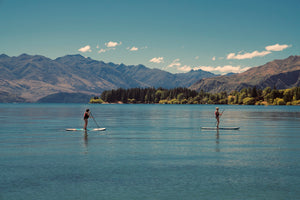Starting Off - What Stand Up Paddle Board Do I Need?
Apr 12, 2019
It's only a matter of time until the sport known as Stand Up Paddle Boarding, SUP for short, gets a hold of you. We've all seen the sport grow in popularity over the last few years and let's be honest, once you try it you are hooked! It's such a great form of exercise whilst being out on the water. But, from hard boards to inflatables and surf-style boards to yoga boards, where do you begin when wanting to buy your first Stand Up Paddle Board?
With so many different Paddle Boards available on the market today, we thought it would be a good idea to help you guys out and give you some of our knowledge on boards for starting out. Let's have a look...
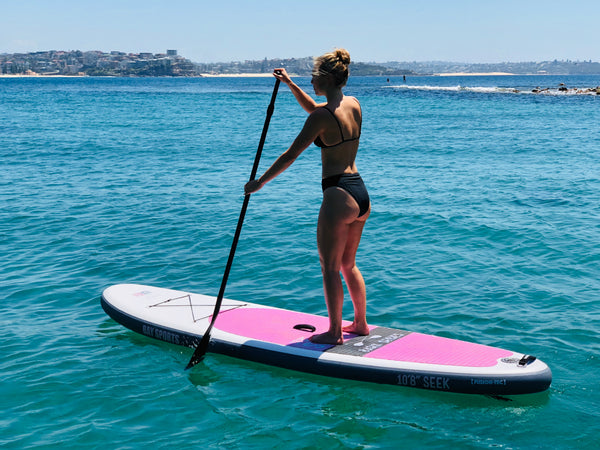
Select Your Style
Before you rush out and buy your first Stand Up Paddle Board, do you know what style of riding you are going to be doing? If you only thought there was just one style of SUP, let us just highlight them for you to make your first buy easier.
All Round SUP- All-around boards are usually thicker, wider and longer than other SUP style boards. They usually range in between 10′ to 12′ in length and 29” to 36” in width. All around boards are the most adaptable types of SUP boards. As the name suggests, they are great in all kinds of conditions. Unless you are going to spend most of your time in the surf, there's a good reason to go for another type of SUP board. But, an all-around board such as the 10'6 EXPLORE is probably the best paddle board for beginners. All around paddle boards are designed to perform well in many conditions, from flat water to surf. It just depends if you want to progress in a certain area.
SUP Surfing - If you want to ride the waves and be out in the surf, a SUP surfboard is your best choice. Generally meant for intermediate and advanced paddlers, SUP surfboards are typically shorter such as the 8'10 RIDER (max. 10′), narrower and have a narrower nose and tail than all-around models. This makes them a lot easier to manoeuvre in waves a and at a closer look, they are usually modelled on a surfboard template. The sharpened sides of the board, called the ‘rails’ and the deep double concave from the middle of the board all the way to the back make this a great paddle board for sup surfing.
Touring SUP - Touring boards are usually longer than all-around boards (usually they come in 11’6” to 14′ in length such as the 11'6 TOUR) and have a pointed nose and typically have little to no rocker. These boards are great if you know you’ll spend your time cruising lakes, rivers or even for open ocean touring.
Racing SUP - Similar to a touring SUP is a race board. Compared to touring boards, race SUPs like the 12'6 SPRINT are much narrower giving them less drag and more speed. The downside is that this makes race SUPs slightly less stable and more difficult to stand easily on.
Kids SUP - Stand up paddle boarding isn't just a great activity for you, but for your kids too. Not only is Stand Up Paddle Boarding extremely fun to do by themselves or with friends but it also gets your children in the fresh air, helps to build their water confidence and has many great health benefits by getting kids active. The right SUP board for a child will depend on their height and weight, but most SUP boards for kids are shorter than 9′ (check out the 8'10 RIDER). The shorter board makes it a little easier for children to carry and manoeuvre.
Yoga SUP - Doing your morning yoga routine on a Stand Up Paddle Board is a new trend called Yoga-on-Water (YOW). It’s perfect for people who are looking to get fit but who are tired of the usual gym setup. As you try to balance on your board, you are actually training your muscles and core strength. A yoga SUP board is generally wide for more stability and balance, whilst also having a larger traction pad area such as seen on the 11' MANDALA Yoga SUP. Many prefer an inflatable yoga paddle board as the surface is a little softer.
A Stand Up Paddle Board must be able to carry your weight. If the board does not have enough buoyancy to support you, the board will seem less responsive, you'll have a less optimal paddle board experience and the board may even sink under you. The volume of the board plays a big part and its maximum weight capacity are therefore important factors for you to consider.
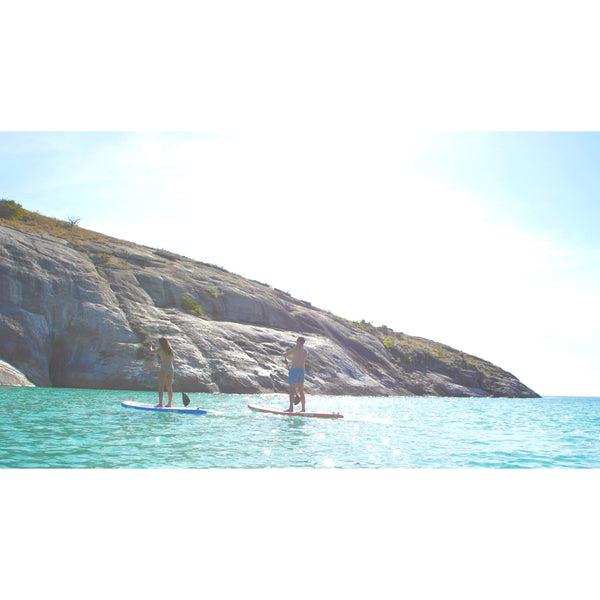
Volume - The volume of a paddle board, measured in litres, is a suggestion of how much weight the SUP board can float. The more volume the board has, the more weight the board can hold. A shorter board can have a higher volume if it is wide and thick. and the same goes for a longer board that can have a lower volume if it is narrow and thin. How much volume you need, also depends on the type of paddle boarding you intend to do and upon your skill level.
Maximum Weight - Not all paddle board manufacturers provide the volume of their boards. In these cases look for the maximum weight capacity. Again, if the board can’t support your weight, it will ride lower in the water, give that sinking, sluggish feeling and be more difficult to paddle. When considering the essential weight capacity, keep it wide and don't go for 'exact' weight details. Some Stand Up Paddle Board manufacturers are a bit too hopeful with the maximum weight capacity they mention in the specs, so don’t judge a board on its weight capacity limit, but choose a board that has excess capacity, since this will generally give you a better paddle boarding experience.
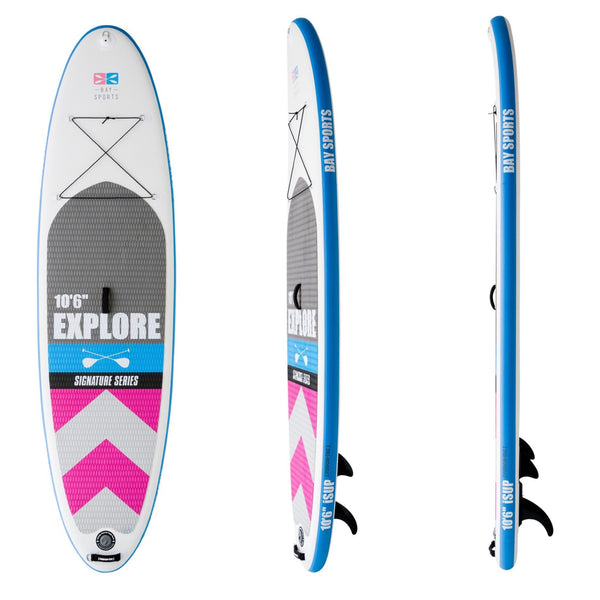
Length: when choosing the length of a SUP board, consider how you will use it. For SUP surfing you need more manoeuvrability, and therefore a shorter board. For touring on the flat water of a calm lake, you’d prefer a board that tracks well, so you’d pick a longer board.
In general, this is worth knowing:
- Short boards under 9′ are great for surfing.
- Medium boards ranging from 9′ to 12′ are ideal for paddle boarders looking for a good time or beginners to paddle boarding.
- Longer boards of 12′ to 14′ are great for touring or racing.
Width: the width of a paddle board to a large extent determines the stability of the board: The wider the board the more stable the board will be. However, the narrower the board, the less drag the board will have through the water. So narrower boards are generally faster than wider boards, at the expense of stability.
Thickness: especially with inflatable paddle boards the thickness of the board determines how rigid the board is. Thinner inflatable SUP boards (4”) are often not rigid enough for a heavier paddler, giving less stability while paddling. An often used test to determine whether an inflatable paddle board is rigid enough is to place the board with the nose and tail section on two chairs and to stand in the middle of the board. The best inflatable paddle boards are usually 6” thick and are remarkably rigid during this test. They hardly bend at all.
However being 6" thick, you stand higher on the water, so these boards tend to be more wobbly and rock side to side. Bay Sports Signature Series range use an advanced construction technique called Fusion-Tec™, which utilises a reinforced PVC material and allows unparalleled stiffness in just a 5" thick board. (You can view this range here)
Inflatable or Hard Board
Whether you’re just heading to the beach for a paddle or hopping on a plane for a long getaway, there’s no denying that transporting an Inflatable SUP board is pretty much stress free. There’s no need to invest in roof bars for your car or borrow a large wagon every time you want to take your board out as it will easily fit inside. Most boards will come with a storage bag, usually in the form of a backpack, big enough to fit everything from board to pump to paddle. Once the board is deflated, simply roll it up, pop it back into its case and throw it in the boot of your car… it really is that simple.
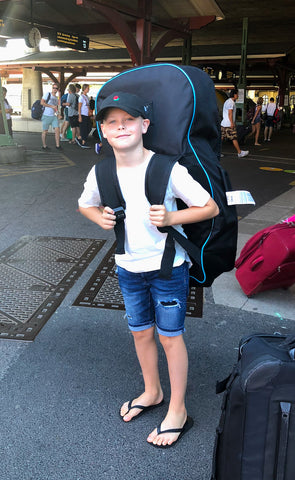
That being said, there are still people that prefer having that solid hardboard under their feet. If you have the storage space, or you have maybe had a lesson on a hard board and found it to be practical, there really is no right or wrong.
A Leash
Now, you may not always need a Leash and especially if you are on flat, calm water. But, having a leash can make a big difference. It can be your life-line between you and your board. It may also stop those terrible accidents... you know when your board gets caught up in the surf and takes out a few surfers.
There are a few different options on the market, the main difference being either coiled leashes or standard straight leashes and it really comes down to personal preference. Some prefer to have their board within reach should they come off whilst others prefers a bit of distance to avoid impact should they fall. Both are designed to keep the board attached to you so you do not become separated.
The Paddle
Coming in a variety of styles and designs, buying a paddle might take a little research. Firstly, the constructions can vary, using materials such as plastic, aluminium, wood and carbon fibre. Finding a paddle that fits your budget and your style of riding can be a big factor. If you struggle with storage space or are looking at getting an inflatable stand up paddle board then a three piece paddle is something to consider.
The paddle breaks down into three pieces, making packing for trips that involve getting on a plane, super easy as your board, pump and paddle can all fit in one convenient bag. Paddles also come with a variety of handles, blades and adjustable lengths.

The general rule is that the paddle used with your paddle board should always be 6 to 10 inches above the height of the paddler. Your paddle size will vary from use in flat water and use in the surf. Your paddle should be on the longer side for flat water use and the shorter side for use in the surf. The blade has usually been designed bent at a slight angle to the shaft which allows for more forward reach when taking a stroke in the water. Oh, and make sure you have your paddle round the right way when out on the water.
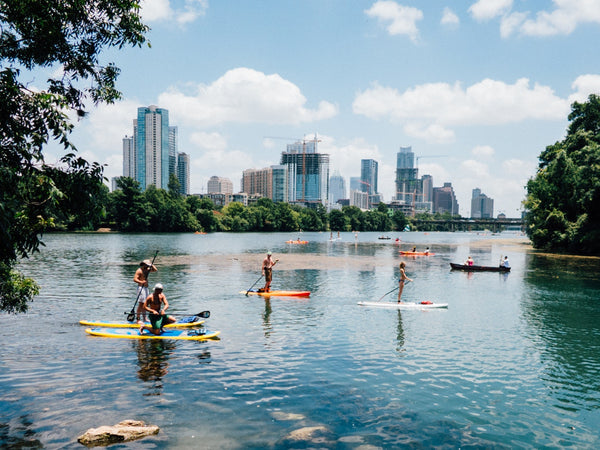
What Are You Waiting For?
Hopefully, after reading those nice little nuggets of information you've got a clear idea in your head about what you are after. So why don't you head over to Bay Sports to check out our range of paddle boards. We are confident that your first board is waiting for you in our warehouse! Whether you are a racer or a cruiser, we have something for you!
Plus if you fancy a little extra reading, check out our guide on Stand Up Paddle boarding right here.
If you are still unsure or need some more advice then why not give us a shout as we are happy to help and answer any questions you may have... no matter how big or small! Click the LiveChat icon on the bottom right of your screen or email us here.

